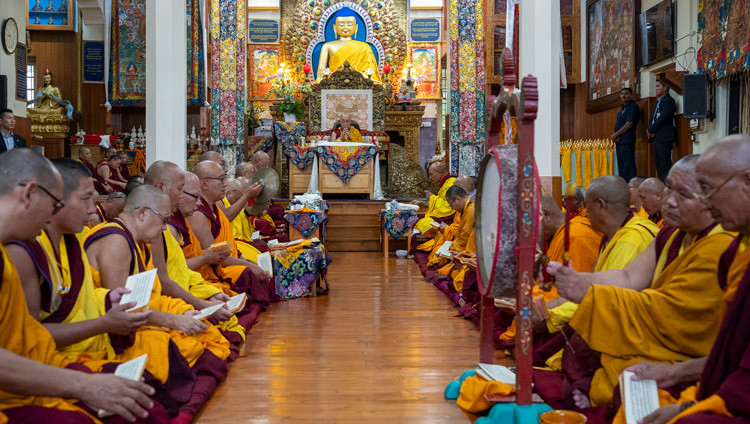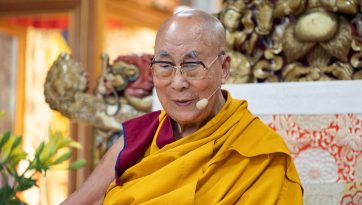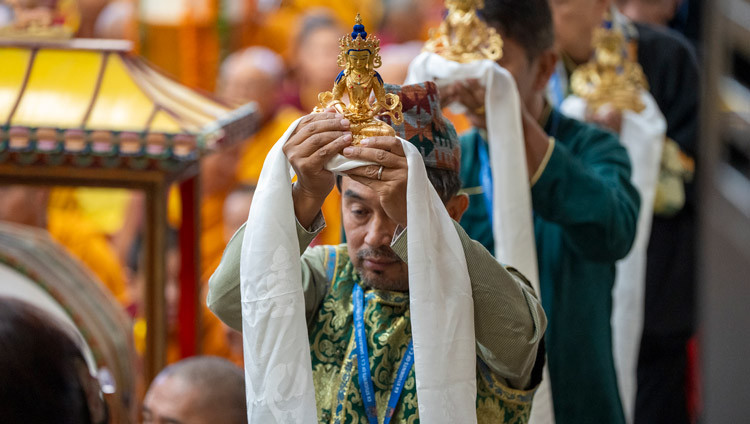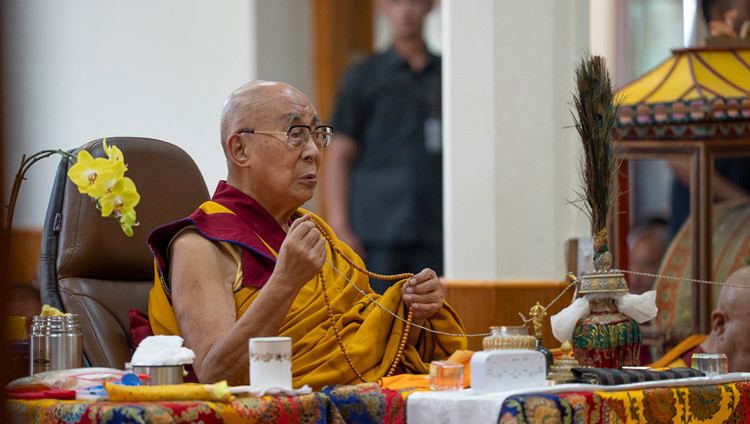The Hundred Deities of the Joyous Land
Thekchen Chöling, Dharamsala, HP, India – The sky was overcast but His Holiness the Dalai Lama’s smile was radiant as he walked into the Tsuglagkhang courtyard this morning. Two Mongolians, a man and a woman, representatives of the 300 of their countrymen and women who had come to hear His Holiness teach, stepped forward to offer him cheese and then curd. He took a pinch of each and then encouraged the couple to taste them too.
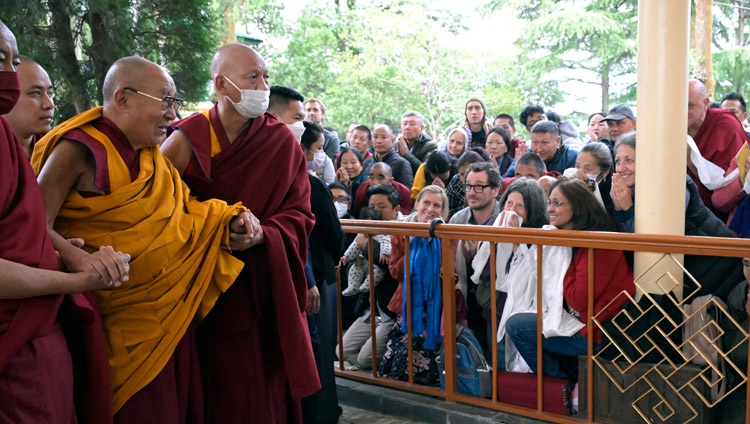
His Holiness the Dalai Lama walking through the courtyard to the Main Tibetan Temple on the first day of teachings in Dharamsala, HP, India on April 19, 2024. Photo by Ven Zamling Norbu
As he walked steadily up the aisle through the middle of the yard to the temple, His Holiness turned to the right and then to the left to greet well-wishers gathered on either side. He paused to take in their smiling faces and waved. He continued to engage with other members of the crowd of an estimated 6100 from 72 countries as he made his round of the temple.
Once His Holiness was settled on the throne a group of laypeople chanted the Heart Sutra in Mongolian. Next, a mandala and representations of the body, speech and mind of the Buddha were offered to him.
“So, today,” His Holiness began, “since we are exiles here in the noble land of India, we have an opportunity to hold a discourse on the Dharma. Jé Tsongkhapa and I came from the same region of Tibet. My birthplace is in the vicinity of his. When I look back, I have tried to preserve the Dharma traditions that flourished in Tibet. I’ve spoken up to protect the environment, to secure peace in the world and to encourage inter-religious harmony. So I can say that someone from near to Jé Rinpoché’s birthplace has made some contribution to the good of the world.
“As I say, I was born near Xining, close to where Jé Tsongkhapa was born. At that time the area was ruled by a Chinese warlord called Ma Bufang. When I was brought to see him, during the search for the reincarnation of the 13th Dalai Lama, he looked at my face and said, ‘There’s something special about this boy’.”
“Those of us gathered here are all followers of the same Buddha. We uphold the Nalanda Tradition, the complete teaching of the Buddha, which we kept alive in Tibet, Mongolia and the Himalayan regions. I’ve had dreams that clearly indicate I am an incarnation of King Trisong Detsen and I have done my best to preserve the tradition established under his direction. I would like to thank all of you for the trust you’ve placed in me.
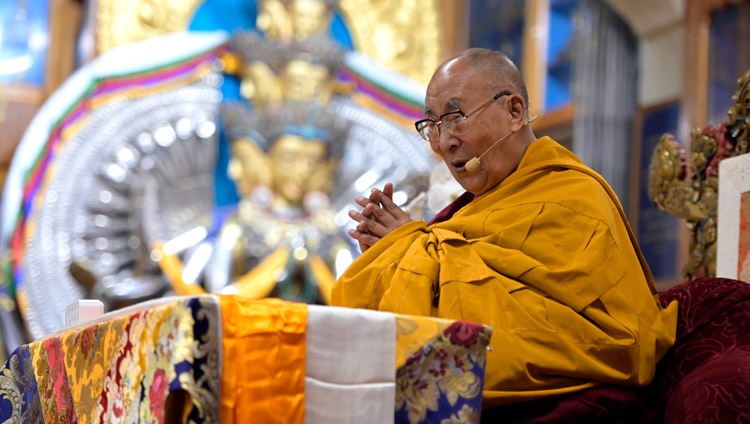
His Holiness the Dalai Lama addressing the congregation on the first day of teachings at the Main Tibetan Temple in Dharamsala, HP, India on April 19, 2024. Photo by Ven Zamling Norbu
“Tibetan Buddhism derives from the instructions the Great Abbot Shantarakshita brought to Tibet. It includes those passed down to us from Nagarjuna and Asanga. The understanding of the workings of the mind and emotions to be found in this tradition is both scientific and of practical value. This understanding of the mind and emotions has the potential to provide a solution to many of the world’s problems.
“I am determined, as long as live, to carry out the aspirations of the Dharma Kings of Tibet. As I’ve already mentioned, I’ve received clear indications that my consciousness belongs to the same continuum as Trisong Detsen’s. Therefore, I am determined to maintain his legacy. And at this time I feel there is an opportunity for the wisdom of the Nalanda Tradition to contribute to the welfare of humanity.
“Today I’m going to read the ‘Hundred Deities of the Joyous Land’, which is a practice of guru-yoga. Like other religious traditions, Hindu and Christian for example, Buddhism of the Nalanda Tradition emphasizes the importance of lineages of transmission.”
His Holiness read the verses of the text where it is written: ‘Even though this is a degenerate age, you elevated this favourable birth by abandoning the eight worldly concerns.’
“We should study what the Buddha taught,” His Holiness advised, “and having done that, should integrate the teaching within ourselves through practice, as Tsongkhapa would have wished.
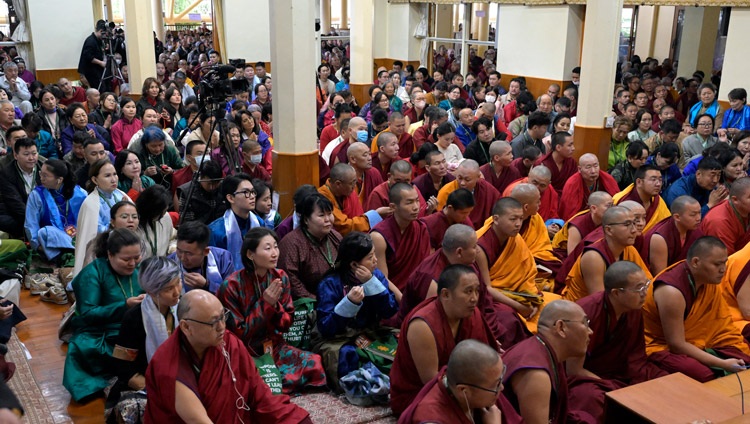
A view inside the Main Tibetan Temple on the first day of His Holiness the Dalai Lama’steachings requested by a group of 300 Mongolians in Dharamsala, HP, India on April 19, 2024. Photo by Ven Zamling Norbu
“Where the verse states, ‘May the essence of the doctrine of the most venerated Sumati Kirti (Tsongkhapa) be illumined forever,’ it is neither exaggerated nor biased because the clarity and comprehensiveness of Jé Rinpoché’s analysis is unique. His broad and extensive explanations can all be subsumed within the Three Trainings in ethics, concentration and wisdom.”
His Holiness recited the verse of praise know in Tibetan as Mig-tse-ma.
You are Avalokiteshvara, great treasure of compassion not aimed at true existence
And Manjushri, master of flawless wisdom
As well as Vajrapani, destroyer of hordes of demons without exception,
O, Tsongkhapa, crown-jewel of the sages of the Land of Snows,
Lobsang Drakpa, at your feet I make requests.
In all my lifetimes, may the Victorious Tsongkhapa
Be my direct spiritual teacher of the Great Vehicle,
And in that way may I not, even for a moment, stray
From the excellent path praised by the Victorious One.
“Jé Rinpoché’s Dharma Protector was Damchen Chögyal and I feel he’s always there helping me too.

His Holiness the Dalai Lama reading from the text ‘Hundred Deities of the Joyous Land’ on the first day of teachings at the Main Tibetan Temple in Dharamsala, HP, India on April 19, 2024. Photo by Ven Zamling Norbu
“We are keeping the Buddha’s teaching alive through study and practice. These days there are scientists, and other people whose traditional religion may not be Buddhism, who are taking interest in what the Buddha taught. They appreciate these instructions that can help us tackle our emotions.”
His Holiness observed that when we do this meditation on Jé Tsongkhapa we visualize him with a sword standing on a lotus-flower to his right and a scripture resting on a lotus to his left. The sword indicates how his wisdom cuts through ignorance and the scripture reveals the fullness and profundity of his knowledge.
“We’ve lost our country and come into exile, but this time has been meaningful. I urge all of you to do your best to practise the teachings. Tashi delek.”

